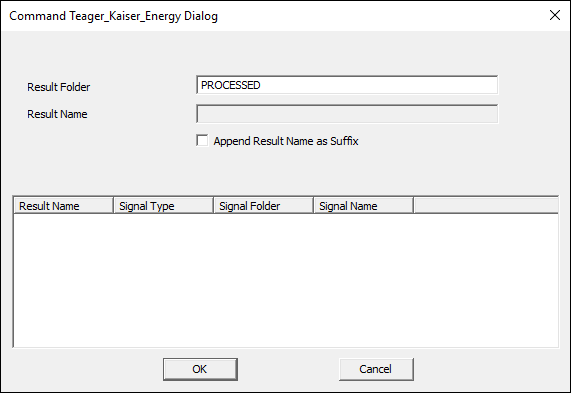Teager Kaiser Energy
Teaker-Kaiser Energy Operator
/TEAKER_KAISER_ENERGY /SIGNAL_TYPES=ANALOG /SIGNAL_NAMES=EMG_A+EMG_B+EMG_C /SIGNAL_FOLDER=PROCESSED ! /SIGNAL_COMPONENTS= ! /RESULT_FOLDER=PROCESSED ! /EVENT_SEQUENCE= ! /EXCLUDE_EVENTS= ; This command is based on the following article:
Solnik S, DeVita P, Rider P, Long B, and Hortobágyi T (2008) Teager–Kaiser Operator improves the accuracy of EMG onset detection independent of signal-to-noise ratio, Acta Bioeng Biomech. 2008 ; 10(2): 65–68 Abstract
A temporal analysis of electromyographic (EMG) activity has widely been used for non-invasive study of muscle activation patterns. Such an analysis requires robust methods to accurately detect EMG onset. We examined whether data conditioning, supplemented with Teager–Kaiser Energy Operator (TKEO), would improve accuracy of the EMG burst onset detection. EMG signals from vastus lateralis, collected during maximal voluntary contractions, performed by seventeen subjects (8 males, 9 females, mean age of 46 yrs), were analyzed. The error of onset detection using enhanced signal conditioning was significantly lower than that of onset detection performed on signals conditioned without the TKEO (40 ±99 ms vs. 229 ±356 ms, t-test, p = 0.023). The Pearson correlations revealed that neither accuracy after enhanced conditioning nor accuracy after standard conditioning was significantly related to signal-to-noise ratio (SNR) (r = −0.05, p = 0.8 and r = −0.19, p = 0.46, respectively). It is concluded that conditioning of the EMG signals with TKEO significantly improved the accuracy of the threshold-based onset detection methods, regardless of SNR magnitude. Calculation
TKEO= x^2(n) - x(n+1)x(n-1) where x is the EMG value and n is the frame number

